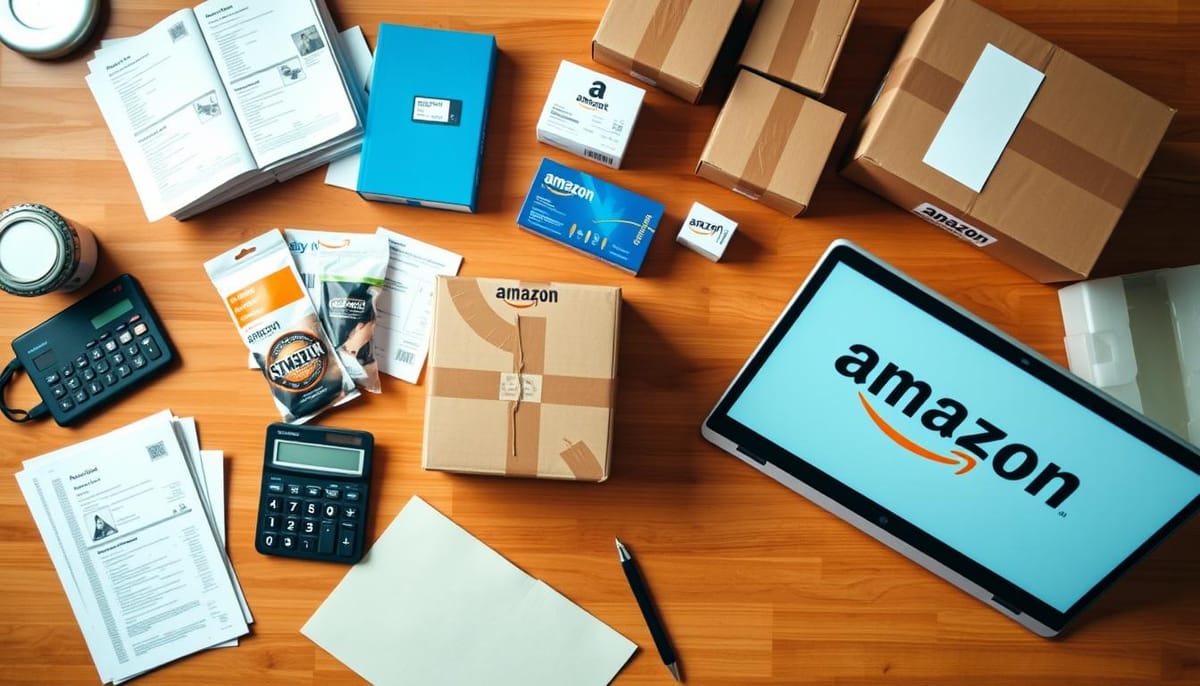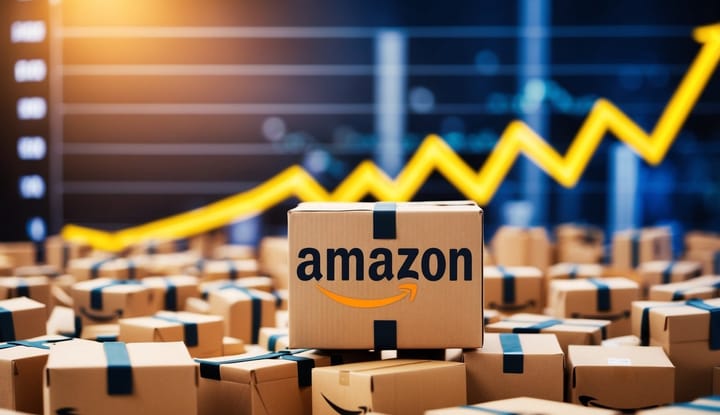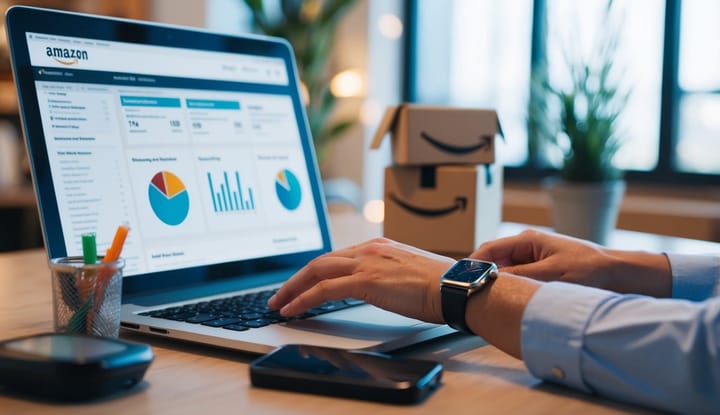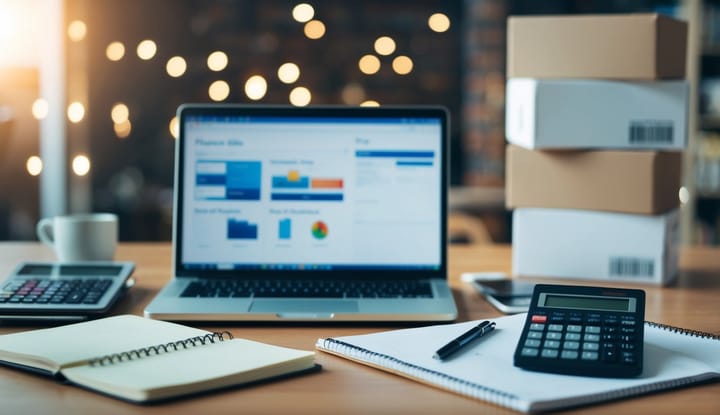Amazon FBA Startup Costs: How Much to Sell on Amazon in 2024?

Imagine a bustling warehouse in the USA, filled with boxes ready to ship around the world. That's the power of Amazon FBA in action. In 2023, Amazon made a huge $574 billion, with a big part of that from third-party sellers. As we move into 2024, more entrepreneurs want a piece of this market. But, the big question is: What does it cost to start selling on Amazon?
Let's explore Amazon FBA and find out what it costs to start. Whether you're an experienced business owner or just starting in e-commerce, knowing these costs is key to your success on Amazon.
Starting as an Amazon FBA seller is exciting but comes with costs. You'll need to think about inventory, software, selling plans, and fulfillment fees. Most new sellers spend between $1,000 and $5,000 to begin. Some start with just $500, while others invest more.
It's no surprise that 82% of sellers use Fulfillment by Amazon (FBA). This is because 51% of customers start looking for products on Amazon. With so many customers, the chance for profit is huge. In fact, 40% of sellers make $1,000 to $25,000 a month.
Key Takeaways
- Amazon FBA startup costs typically range from $1,000 to $5,000
- 82% of third-party sellers use Amazon FBA
- 51% of consumers start product searches on Amazon
- 40% of Amazon sellers make $1,000 to $25,000 monthly in sales
- Most sellers start their Amazon business with $1000 or less
- 58% of sellers become profitable within their first year
Understanding Amazon FBA: An Overview
Amazon FBA changes the game for online sellers. It makes handling orders easy, letting businesses grow faster. Let's dive into this service and see how it changes online shopping.
What is Amazon FBA?
FBA means Fulfilled by Amazon. It's a service where Amazon takes care of storing, packing, and shipping products for sellers. This makes things easier for sellers, helping them reach more customers.
Benefits of using Amazon FBA
Amazon FBA has many perks:
- Prime eligibility: Products get Prime status, drawing in more customers
- Increased sales: FBA items often top search results
- Time-saving: Amazon takes care of customer service and returns
- Scalability: Easily handle more stock during busy times
How Amazon FBA works
Here's how FBA works:
- Send your stock to an Amazon center
- Amazon keeps your products safe
- Customers buy your items
- Amazon packs and ships the order
- Amazon deals with customer service and returns
| FBA Feature | Benefit |
|---|---|
| Prime Shipping | 25% more off-Amazon sales |
| Subscribe & Save | Up to 1.8X more sales |
| Shipping Costs | 70% cheaper per item than other services |
Using FBA helps sellers save time, cut costs, and increase sales. It's a key tool for growing an e-commerce business on Amazon.
Essential Costs to Start Selling on Amazon
Starting an Amazon business means facing upfront costs. These costs can change a lot based on what you sell and how you plan to sell it. Let's look at the main expenses you'll see when you start selling on Amazon.
Inventory is a big cost for sellers. You might spend from $750 to over $100,000 on it, depending on your products. You'll also need to spend on product samples, which can be $50 to $500. These samples check the product quality before you buy more.
Creating your product is key and can cost $500 to $10,000 or more. This includes design, making prototypes, and manufacturing. Designing your product listing is also important and can cost $200 to $5,000. Marketing can cost from $10 to over $1,000, depending on your plan.
Amazon has fees you can't avoid. These include a $39.99 monthly fee for professional sellers and fees based on what you sell. For example:
- Clothing and Accessories: 5% for sales up to $15, 10% for $15-$20, and 17% for over $20
- Electronics: 8% referral fee
- Furniture: 15% for sales up to $200, 10% for sales over $200
Other costs include registering your business ($0-$1,000+) and a $30 barcode from GS1. These are just the basics. Your actual costs will depend on your business and products. Planning and budgeting well are crucial to manage your Amazon selling costs.
How Much Is It to Start Amazon FBA?
Starting an Amazon FBA business needs careful cost planning. Many people ask, "How much money do you need to start selling on this platform?" The cost can change a lot, based on different factors.
Minimum Investment Requirements
The cost to start can be as low as $500. But, a more realistic amount is $1,000 to $5,000. Recent data shows:
- 14% of sellers started with $500 or less
- 23% invested between $1,000 and $5,000
- 18% used $5,001 to $10,000 to launch their business
Breakdown of Startup Costs
When planning your Amazon FBA startup, think about these key costs:
| Expense Category | Estimated Cost |
|---|---|
| Initial Inventory | $1,000 - $3,000 |
| Professional Seller Account | $39.99/month |
| Product Photography | $270 - $450 |
| Graphic Design | $30 - $500 |
| Shipping | Varies (calculate at freightos.com) |
Factors Affecting Initial Investment
The cost to start selling on Amazon FBA depends on several things:
- Product type and complexity
- Sourcing method (domestic or international)
- Business scale (number of products)
- Marketing budget
Starting with less is possible, but a bigger initial investment can lead to faster profits. 32% of sellers with over $10,000 in investment made a profit in less than a month. On the other hand, 66% of those starting with $500 or less took up to six months to make a profit.
Amazon Seller Account Options and Fees
Choosing the right seller account on Amazon is key to your success. Amazon has two main account types: Individual and Professional. Each has different fees and features.
Individual vs. Professional Seller Accounts
The Individual account is great for beginners or those selling fewer than 40 items a month. It costs $0.99 for each item sold. A professional seller account, on the other hand, costs $39.99 a month but lets you sell as much as you want.
| Account Type | Monthly Fee | Per-Item Fee | Best For |
|---|---|---|---|
| Individual | $0 | $0.99 | Low-volume sellers |
| Professional | $39.99 | $0 | High-volume sellers |
Referral Fees
Amazon also has referral fees, which vary by product type. These fees are a percentage of the sale price, from 8% to 45%. For example, Amazon charges 13% for cars and 11% for clothes.
Fulfillment Fees
If you use Fulfillment by Amazon (FBA), you'll pay extra for storage and shipping. These fees depend on your product's size and weight. For small items under 1 pound, it's $2.50. But for items over 3 pounds, it's $8.26.
It's important to know these fees to figure out your profits and pick the best account for selling on Amazon.
Additional Expenses for Amazon FBA Sellers
Selling on Amazon FBA is more than just paying for products and fees. Smart sellers use tools and services to grow their business. Let's look at some key expenses that can help you succeed on Amazon.
Amazon PPC is crucial for many sellers. It makes your products more visible in search results. You should plan to spend at least $10 a day on ads. This amount can change based on your niche and how competitive it is.
Being part of the amazon brand registry is beneficial. It protects your brand and gives you more features. Getting a trademark, a must for the registry, costs between $500 to $2,000. This is a one-time cost that can pay off over time.
Good photos are key to selling products. Professional product photography can cost from $50 to $500 per item. High-quality images can significantly increase your sales.
- Market research tools: $50 - $1,000+ monthly
- Graphic design: $100 - $2,500 per project
- Amazon FBA course: $297 - $997
Tools for sellers can make managing your business easier. Options include SellerAmp ($19.95/month) for keyword research and Keepa ($20/month) for tracking prices. These tools help you sell smarter by optimizing your listings and pricing.
Taking an amazon fba course or coaching can also help you learn faster. Courses cost from $297 to $10,000 depending on what you are looking for. They offer valuable insights for both new and experienced sellers.
Remember, these costs are investments in your business. They can lead to better decisions and higher profits on Amazon.
Conclusion: Is Amazon FBA Worth the Investment in 2024?
Looking at Amazon FBA in 2024, it's clear it's still a great choice for entrepreneurs starting an Amazon business. With almost half of Amazon's sales from third-party sellers, it's a booming market. The drop in referral fees for products between $15 and $20 is a big win for sellers in that range.
Amazon FBA makes starting an ecommerce business easy. It takes care of logistics, shipping, and customer service, letting sellers grow their business. This efficiency is shown by 39% of sellers working less than 10 hours a week. Also, 20% of successful sellers make profits in just three months.
But, starting a business on Amazon isn't without its hurdles. With millions of sellers, the competition is tough. Managing inventory well is key, as too much stock can lead to extra fees and losses. To do well, sellers need to put effort into finding the right products, making their listings stand out, and marketing smartly. While starting costs vary, the chance for success makes Amazon FBA an attractive choice for those entering ecommerce in 2024.
Frequently Asked Questions
Q: What is the Amazon FBA startup cost for beginners in 2024?
A: The Amazon FBA startup cost can vary widely, but typically ranges from $500 to $3,000 for beginners in 2024. This includes costs for inventory, product research tools, and initial Amazon fees. Keep in mind that your exact costs will depend on factors like the products you choose to sell and your business model.
Q: How much does it cost to start an Amazon business using FBA?
A: To start an Amazon FBA business, you'll need to consider several costs. These include the Professional Seller account fee ($39.99 per month), inventory costs (varies), product research tools ($20-$100 per month), and initial marketing expenses. A reasonable estimate to get started is around $1,000 to $5,000, depending on your product and scale.
Q: What are the ongoing costs of selling on Amazon FBA?
A: Ongoing costs for selling on Amazon FBA include Amazon's referral fees (typically 8-15% of the sale price), FBA fees (which cover picking, packing, and shipping), storage fees (which vary based on the size of your products and time of year), and inventory replenishment costs. You'll also need to factor in costs for marketing, product research tools, and potentially professional services like accounting.
Q: How can I reduce the cost of selling on Amazon FBA?
A: To reduce costs, consider strategies like optimizing your inventory to avoid long-term storage fees, choosing products with higher profit margins, using efficient packaging to minimize FBA fees, and leveraging Amazon's promotional tools to increase sales without additional marketing spend or via influencer marketing. You can also start with a smaller product line to keep initial costs low.
Q: What are the shipping costs associated with Amazon FBA?
A: With Fulfillment by Amazon (FBA), you don't pay for shipping to customers directly. Instead, shipping costs are included in the FBA fees, which vary based on the size and weight of your products. However, you'll need to cover the cost of shipping your inventory to Amazon fulfillment centers, which can be optimized by using Amazon's partnered carrier rates.
Q: How much money do you need to start selling on Amazon FBA?
A: The amount you need to start selling on Amazon FBA can vary, but a good rule of thumb is to have at least $1,000 to $5,000 available. This should cover your initial inventory costs, Amazon fees, and basic marketing expenses. Having more capital can help you start with a larger inventory and more robust marketing efforts, potentially accelerating your business growth.
Q: What are the inventory costs for an Amazon FBA business?
A: Inventory costs for an Amazon FBA business can vary greatly depending on your product choice and supplier. On average, new sellers might spend anywhere from $500 to $3,000 on initial inventory. It's important to balance having enough stock to meet demand without overinvesting and incurring high storage fees. As your business grows, inventory costs will likely increase.
Q: How much does Amazon charge for storage in their fulfillment centers?
A: Amazon's storage fees vary based on the time of year and the size of your products. As of 2024, standard-size items are charged $0.75 per cubic foot from January to September, and $2.40 per cubic foot from October to December. Oversize items have higher rates. Long-term storage fees apply to items stored for more than 365 days, which can significantly increase costs if inventory doesn't sell quickly.
Q: What's a summary of Amazon FBA startup costs for a new business in 2024?
A: A summary of Amazon FBA startup costs in 2024 includes: Professional Seller account ($39.99/month), initial inventory ($500-$3000), product research tools ($20-$100/month), product photography ($20-$500), initial PPC advertising ($200-$500), and miscellaneous costs like sample products and packaging. Total startup costs typically range from $1,000 to $5,000, but can be higher depending on your specific business plan and product choices.
Q: How can Amazon's FBA program help grow your business?
A: Amazon's FBA program can help grow your business by handling storage, packaging, and shipping of your products, which allows you to focus on product selection and marketing. It also makes your products eligible for Amazon Prime, potentially increasing your visibility and sales. FBA can help you scale more easily, as Amazon handles increased order volumes without you needing to invest in additional infrastructure. However, it's important to balance these benefits against the costs to ensure profitability.
Ready to Launch Your Amazon FBA Business—Smarter?
Join our mini-course at WAH Academy and learn how to budget, pick the right tools, and turn your startup capital into real sales—whether you’re starting with $500 or more.
No guesswork. No fluff. Just practical steps to get your store off the ground.
Tap the button and start building your Amazon business today.



